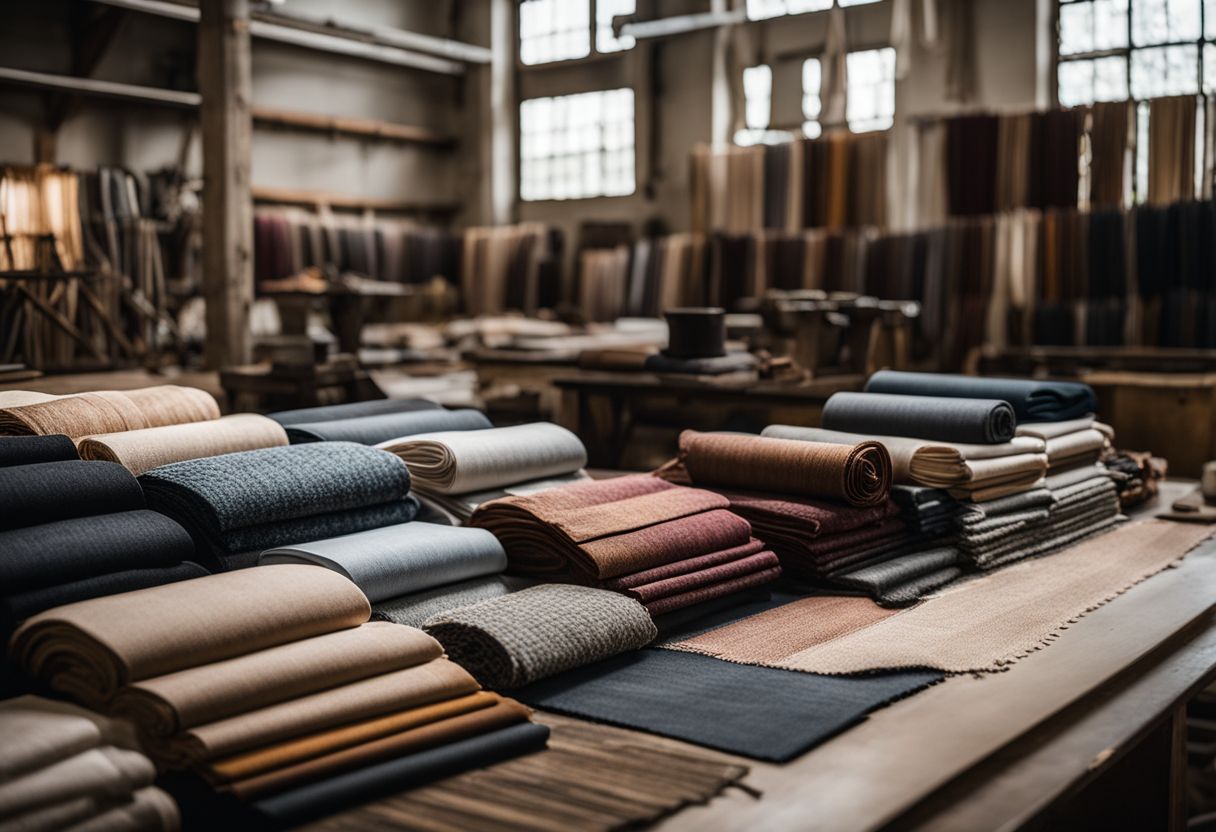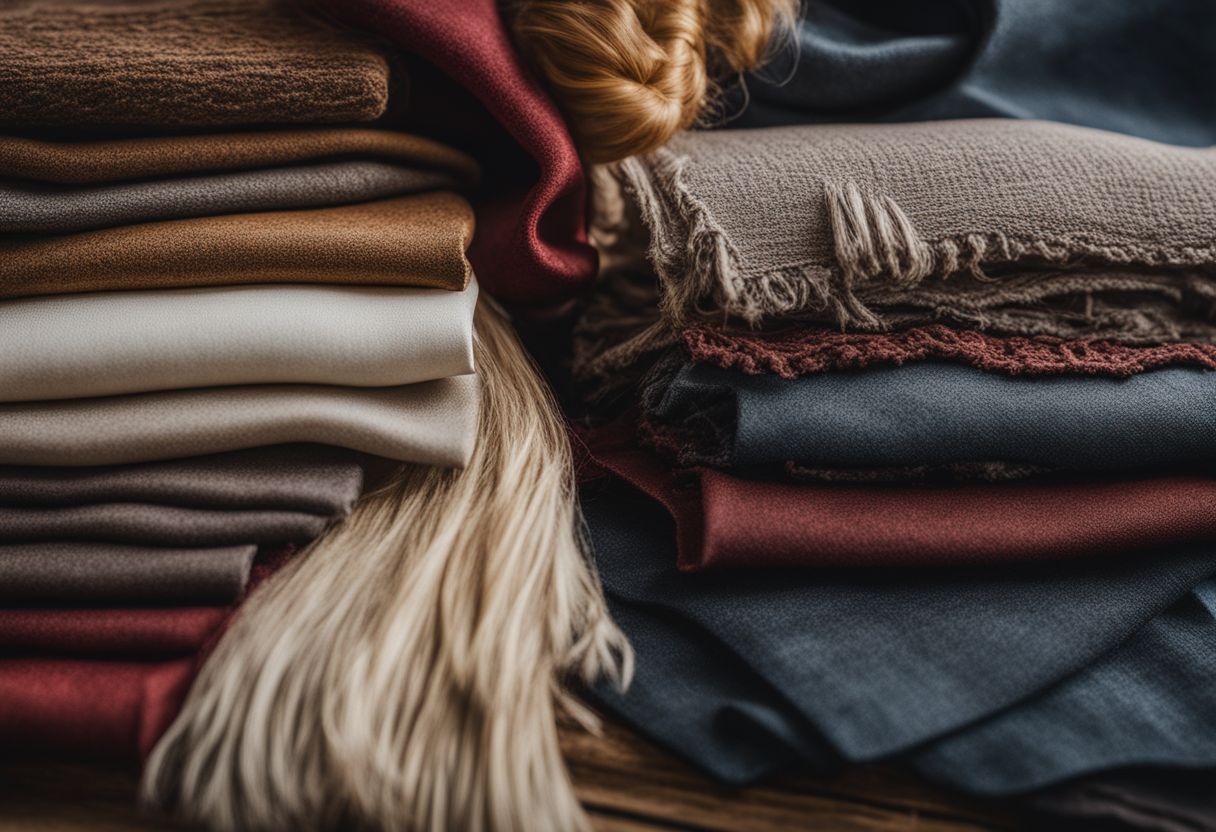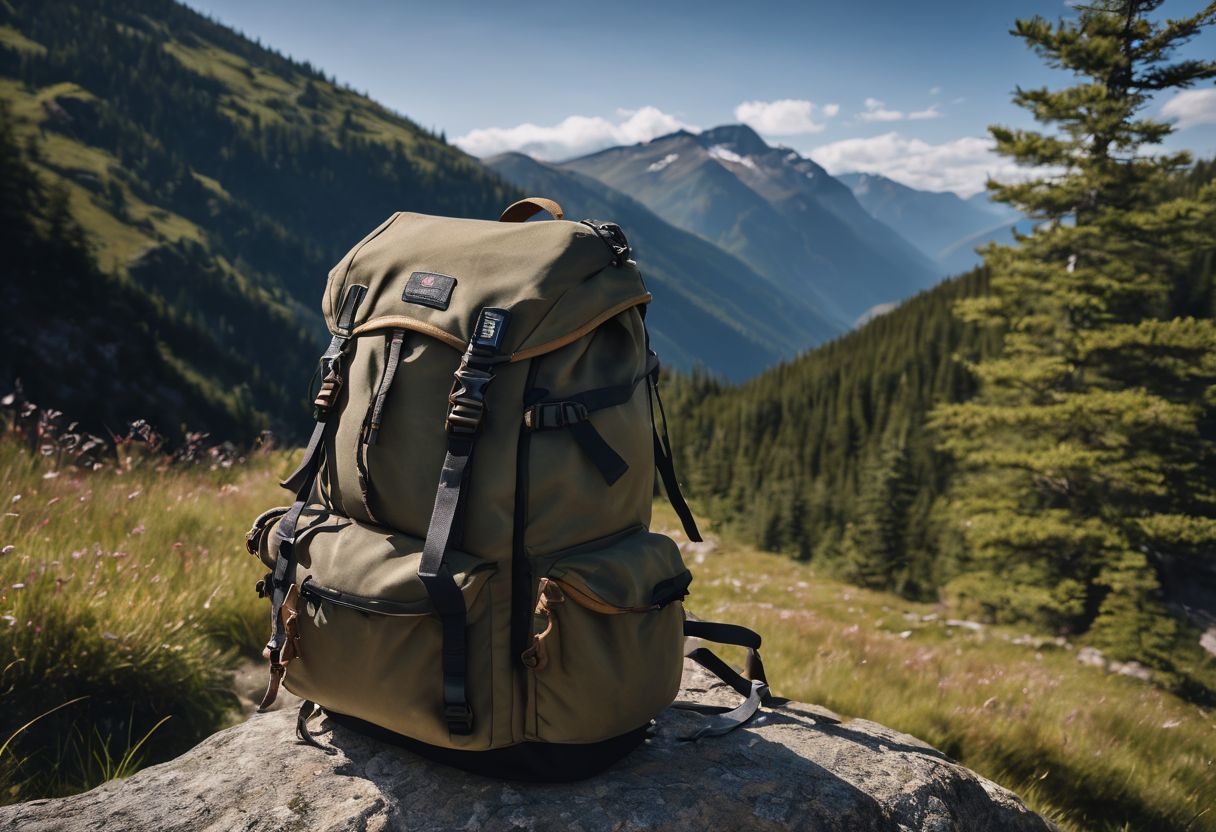A rugged rucksack that withstands the test of time isn’t just about the brand or style—it’s forged on the loom where every thread interlaces to create fabric strong enough for any adventure.
With over a decade spent in textile production, I’ve examined countless fabrics under microscopic scrutiny, learning that the secret to a rucksack’s resilience lies in its weave. My expertise extends from manipulating warp and weft threads into intricate patterns to understanding how these techniques impart strength and functionality.
Unveiling these textiles’ mysteries offers more than academic satisfaction; it empowers you with practical wisdom to select gear that triumphs over wear and tear. Whether you’re scaling mountains or navigating urban jungles, knowing your rucksack’s fabric can be as crucial as what’s packed inside it.
Dive further into this blog post where durability meets design—your ultimate guide awaits.
Key Takeaways
- Understanding fabric weaves is crucial for selecting a durable and functional rucksack material.
- Twill weave offers exceptional strength and resistance to wear and tear, making it a top choice for rugged rucksack use.
- Consider factors such as weave density, fabric weight, water resistance, and comfort when choosing the right fabric weave for your intended rucksack use.
- Other considerations include the weight of the fabric, its water and weather resistance properties in relation to durability.
Understanding Fabric Weaves

Fabric weaves play a crucial role in determining the durability and functionality of rucksack materials. Understanding the different types of fabric weaves is essential for choosing the right one for your specific needs.
Importance of fabric weave in determining durability and functionality
The way threads are woven together makes a big difference in how tough and useful a rucksack can be. Take the plain weave, for example; its simple crisscross pattern forms a strong fabric that won’t fall apart easily.
This is why it’s common to find this type of weave in backpacks that need to be durable. And when you look at satin weaves, they not only give off a nice shine but also play an important role in how the fabric works.
Their smooth surface can mean less wear and tear from rubbing.
To know if you’re picking a sturdy backpack, check out the weave density—how many yarns are there in an inch both up and down (warp) and left to right (weft). A higher count often means better quality and longer-lasting gear.
Weave types like twill or jacquard add extra strength because their patterns help spread stress over more threads. So whether you’re going hiking or just carrying books, understanding these weaving methods helps choose the right rucksack to stick by your side for years.
Basic definition of fabric weave
A fabric weave is how threads or yarns come together to make cloth. Think of it like a crisscross pattern, with one set of threads running up and down called warp yarns, and another set weaving in and out of them called weft yarns.
This crossing makes many different kinds of weaves for all sorts of fabrics. Each type has its own look and strength.
One simple kind is the plain weave where each weft thread crosses over one warp thread then under the next, and each row alternates. It’s like the basic moves in a dance that other styles build on.
This plain weave creates strong fabric that’s used everywhere from shirts to rucksacks.
Common Types of Fabric Weaves

The common types of fabric weaves include plain weave, basket weave, twill, satin, jacquard, and canvas. Each type has its own unique characteristics and uses in rucksack construction.
Plain weave
Plain weave is the most basic and common type of fabric weave. It’s made by crossing warp and weft threads over and under each other in a simple crisscross pattern. This straightforward technique makes plain weave fabrics strong and hard to tear, which is why they are a popular choice for rucksacks.
Clothes like t-shirts often use plain weave too.
Because it’s so simple, plain weave doesn’t stretch much, which helps rucksacks keep their shape even when they’re full or heavy. Plain-woven fabrics can also be tightly packed with threads, which boosts their durability against wear and tear from everyday use or rough outdoor activities.
Stuff like denim and canvas are examples of tough materials made from this kind of weaving that many sturdy rucksacks are made from.
Basket weave
Basket weave looks like a basket, made by weaving two or more warp threads with two or more weft threads. It creates a balanced weave with equal warp and weft floats. This makes it flexible but not very durable.
Baskets created for aesthetic reasons often have intricate patterns, striking colors, and flexible fibers, making them ideal for decorative use. Also known as Panama weave, this simple textile weave involves each thread traveling over two then under two threads in a criss-cross pattern using multiple warp and weft threads to create a distinct appearance.
Twill
Twill is a fundamental weave used in textile production, known for its unique diagonal pattern distinct from plain or satin weaves. This weaving technique creates strong, durable fabrics with diagonal ridges and lines.
These characteristics make twill fabric notably resilient and versatile for various purposes, contributing to its widespread popularity in the textile industry. The diagonal ribs resulting from the twill weave enhance the fabric’s durability, making it suitable for a range of applications.
Twill is among the original three types of weaves used in textiles alongside satin and plain weaves. Its distinctive properties have made it an essential choice for creating fabrics with strength and endurance due to its unique diagonal pattern created by carefully weaving warp and weft threads.
Satin
Satin weaves are famous for their glossy and smooth appearance, giving off a luxurious feel. These fabrics are made from long continuous filaments, creating a sleek finish. The unique structure of satin weave lets the weft threads float over several warp yarns before going under one weft thread, resulting in the characteristic silky surface.
Satin fabrics drape beautifully and have a lustrous sheen that adds elegance to any rucksack design.
The satin weave’s complexity makes it stand out with its distinctive shiny surface and soft texture. This exquisite fabric is ideal for adding a touch of sophistication while ensuring durability in your rucksack choice.
Jacquard
Jacquard fabric is woven using a special loom, allowing for intricate and detailed patterns to be woven into the fabric. This method creates raised motifs in the fabric, resulting in complex woven-in designs with large repeats or tapestry effects.
Fabrics made with a Jacquard loom can produce an almost infinite variety of weaves, giving rise to a wide range of fabrics with different textures and patterns. Jacquard fabric is particularly distinctive as it features complex patterns woven into the texture rather than being printed, colored, or placed on top.
The term “jacquard” does not refer to a specific material but rather to this method of weaving intricate designs using the Jacquard loom. It is often used for garments, home decor, and accessories due to its textured appearance and unique patterns that stand out from conventional fabrics.
Canvas
Canvas is a tough, plain-weave fabric frequently prized for its durability and water-resistance. It is usually crafted from cotton and occasionally linen, with two primary variations: plain canvas and duck.
Both types are known for their sturdiness and resilience, making them ideal choices for rucksack construction. Originally used as sail cloth material due to its hardwearing nature, canvas has retained its reputation as a versatile and long-lasting fabric suitable for various demanding applications.
Canvas’s inherent qualities make it an excellent choice for manufacturing sturdy rucksacks that can withstand heavy use and harsh conditions. With its strong water-resistant properties, canvas ensures that the contents of the rucksack stay dry even in adverse weather conditions.
How Fabric Weaves Affect Rucksack Durability
Understanding which fabric weaves are most durable is crucial when choosing a rucksack for outdoor activities. Different weaves offer varying levels of strength and resistance to wear and tear, so it’s important to select the right weave for your rucksack’s intended purpose.
Which fabric weaves are most durable
Twill fabrics are particularly durable due to their strong weave structure and ability to resist wear and tear. They are considered more durable compared to plain-weave canvas.
- Twill weaves: Twill fabrics are known for their diagonal rib pattern, which contributes to their strength and durability. The weave’s construction helps prevent tearing and increases fabric resilience.
- Ripstop nylon: This fabric is designed with a special reinforcing technique that makes it resistant to ripping and tearing, making it a highly durable choice for rucksack material.
- Plain weave fabrics: While not as strong as twill, plain weave fabrics offer good durability and resistance to shedding, making them a reliable choice for rucksack longevity.
How to choose the right fabric weave for your rucksack’s purpose
To choose the right fabric weave for your rucksack’s purpose, consider the following:
- Look for higher weave densities to ensure stronger and more durable fabrics with increased abrasion resistance.
- Consider twill fabric, known for its diagonal weave pattern, which creates a durable and resistant material suitable for rugged use.
- Pay attention to fabric weight, as it reflects how the fabric has been woven and finished, impacting its strength and durability.
- Evaluate plain weave fabrics for fine quality due to the one-to-one overlap of warp and weft threads.
- Assess the suitability of twill fabric due to its durability and abrasion resistance, making it an ideal choice for rucksack purposes.
Other Factors to Consider When Choosing a Rucksack Fabric
Consider the weight, water resistance, and comfort of the fabric when choosing a rucksack fabric.
Weight
The weight of the fabric is crucial for making a rucksack. It directly affects the quality and price of the bag. When choosing between two similar fabrics with different weights, the weight becomes particularly important.
However, it’s important to note that the fabric’s weight doesn’t indicate its quality or type; rather, it simply refers to how much a square meter of a specific woven or knitted fabric weighs.
Rucksack materials can range from ultra-lightweight fabrics to thick, durable textiles, posing a challenge in selecting the best option for a bag.
Water and weather resistance
PVC coatings provide excellent water resistance for backpack fabrics, but the level of waterproofing can vary between different fabrics. Nylon has better waterproof properties than cotton, but it has a tendency to tear when pierced, which can be solved by implementing reinforcements.
Canvas backpacks can be water-resistant to some extent, but may not be completely waterproof without additional treatments or coatings. Polypropylene (PP) is less UV resistant than other fabrics, so under repeated or sustained exposure to the sun, PP will start to break down.
Choose the fabric weave and coating carefully based on your rucksack’s intended use and the environmental conditions it will encounter. Understanding these factors will help you select a fabric that offers optimal protection against water and weather elements while ensuring durability and functionality in various outdoor activities.
Comfort and flexibility
Rucksack fabric weaves play a crucial role in ensuring the comfort and flexibility of the backpack. The choice of fabric weave determines how comfortable and easy to move your rucksack will be during outdoor activities.
For instance, PU coated fabric is known for its exceptional flexibility and resilience, making it a preferred choice for comfortable and flexible backpacks. Understanding these nuances in fabric weaves can help you choose a rucksack that provides the right balance of support and freedom of movement during your adventures, enhancing your overall experience.
When selecting a rucksack, it’s essential to consider not only its durability but also how it will feel when you wear it on your back. By taking into account the impact of fabric weaves on comfort and flexibility, you can make an informed decision that ensures your backpack supports your movements while keeping you comfortable throughout your journey.
FAQs
1. What are the different types of weaves for rucksack fabrics?
Rucksack fabrics can have many types of weaves like twills, jacquard weave, leno weave, and pile weave. Each weave has a unique pattern like plaids or stripes.
2. What makes jacquard fabric special for backpacks?
Jacquard fabric is special because it has complex patterns woven into it that Joseph Marie Jacquard invented. It looks fancy and is strong for backpacks.
3. Why do rucksacks use weaves with high thread counts?
High thread counts in fabrics like Cordura make the rucksack tougher and more durable to carry heavy things without tearing.
4. Can you explain what warp and weft mean in fabric weaving?
In fabric weaving, warp means threads that run up and down, while weft means threads that go side to side across the warps to make different patterns.
5. Is there a type of weave that is best for outdoor backpacks?
Yes! Weaves like ultra-high molecular weight polyethylene (UHMW PE) are great for outdoor bags because they’re super strong and don’t get damaged easily by rough use or bad weather.
6. Do people still hand-weave rucksack fabrics today?
Some very special rucksacks might be made from hand-looming techniques where a person called a “weaver” makes the fabric on a loom without machines which can include unique touches not found elsewhere such as waxed cotton finishes or custom embroidery.

